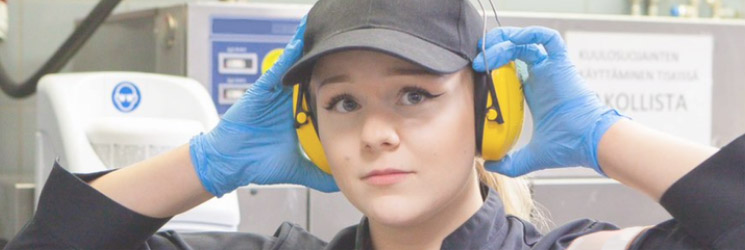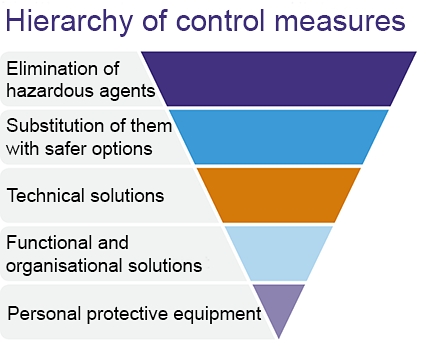

Working conditions
Carcinogenic, mutagenic and reprotoxic agents
Substances that are carcinogenic, mutagenic or reprotoxic are called CMR substances. CMR is an abbreviation of:
- carcinogenic (causes cancer)
- mutagenic (damages genetic material)
- reprotoxic (is hazardous for reproduction).
The use and presence of CRM substances in workplaces is regulated more strictly than other chemical agents.
The following table presents chemicals that are typically found at Finnish workplaces and their hazardous properties:
| Carcinogenic | Mutagenic | Reprotoxic | |
| Ethylene oxide | x | x | |
| Vinyl chloride | x | x | |
| Benzene | x | x | |
| Acrylamide | x | x | |
| 1,3-butadiene | x | x | |
| Hydrazine | x | x | |
| Propylene oxide | x | x | |
| Epichlorohydrin | x | x | |
| Trichloroethylene | x | x | x |
| N,N-Dimethylformamide (DMF) | x | ||
| 1-Methyl-2-pyrrolidone (NMP) | x | ||
| Carbon monoxide | x | ||
| Lead and its compounds | x |
Exposure can cause permanent harm to health
Carcinogenic substances: Cancer is a disease associated with the uncontrolled growth and spread of cells to different parts of the body. Cancer usually develops over a long period of time, showing no symptoms at first. Normally, the body is able to fix and prevent changes to prevent cancer. Cancer is usually diagnosed 10 to 40 years after initial exposure to a hazardous agent.
Mutagenic substances: Agents that can cause mutations in gametes and damage DNA. Mutations in gametes can be harmful and cause hereditary diseases. Many mutagenic substances can also cause cancer.
Reprotoxic substances: Reprotoxic agents can adversely affect reproductive health, fertility or the development of offspring.
Reprotoxic substances are chemicals that are harmful to reproduction and can cause adverse non-hereditary effects on offspring or increase the occurrence of such effects through inhalation, ingestion or skin contact.
Some chemicals may impair sperm formation in testicles and cause infertility. Exposure to organic solvents has been found to increase miscarriages. Toxic substances can cause the death of an embryo or foetus, disturb foetal growth, or cause structural abnormalities or functional changes. They can also adversely affect a breastfeeding child through breastmilk.
Employer’s responsibilities
The employer must assess the nature, amount and duration of exposure in all activities where workers may be exposed to carcinogenic, mutagenic or reprotoxic agents.
The employer must also investigate the risks that exposure causes to workers’ health and safety. The employer must then take the necessary measures to control the hazardous agents.
The employer must primarily replace the carcinogenic, mutagenic or reprotoxic agent with a less dangerous substance, mixture or method.
Order of priority of control measures
The employer must act in the following order of priority to control hazardous agents:
- Where possible, the hazardous agent has to be eliminated by altering the process or product where a hazardous substance is used.
- If the use of the hazardous substance cannot be stopped, it must be replaced with a harmless or less dangerous substance.
- If stopping the use of the substance or process or replacing it is impossible, technical or organisational solutions must be used to prevent or reduce exposure. Such solutions include controlling the source of emissions (closed system or removing airborne impurities at the source), reducing the number of workers being exposed to the hazardous substance and reducing the duration and intensity of exposure.
- Under law, the use of personal protective equipment is the last resort if exposure cannot be sufficiently controlled by other means.
Prevention methods
The employer also has to use the following prevention measures in all activities where carcinogenic, mutagenic and reprotoxic agents are present:
| Prevention method | Tried and tested practical observations |
|
| 1 | The primary aim is to reduce or replace the use of hazardous substances.
|
The primary aim is to reduce or replace the use of hazardous substances.
|
| 2 | Ensuring that the number of workers actually or potentially exposed to the substance remains as low as possible and, where appropriate, limiting their time of exposure.
|
Isolating the work area in question in advance or restricting access to the area, or carrying out the work phase when as few workers as possible are present. Using measures such as warning signs or alarms to warn about the use or formation of hazardous substances at the workplace.
|
| 3 | Designing working methods and technical control measures so that the release of hazardous substances at the workplace is either completely prevented or reduced as much as possible. | Taking the handling of hazardous substances into account already during the work planning phase (e.g. automating and/or encapsulating the work phase). Making ventilation more effective and using efficient filters (e.g. HEPA filters for particles). |
| 4 | Removing hazardous substances released into the air as close as possible to the area where they are released at the workplace by using local exhaust ventilation systems or general ventilation. | Carrying out the work phase e.g. in a fume cupboard or an area with local exhaust ventilation. Using devices at work with integrated dust extraction (e.g. angle grinders, grinding machines, saws). Using movable exhaustion arms correctly |
| 5 | Using the appropriate procedures to measure the hazardous substances in the air at the workplace, especially in order to detect abnormal exposure due to unexpected incidents or accidents early enough. | Personal dosage meter (e.g. 3-gas meter, dosimeter). Carbon monoxide alarm. Using sensors for continuous measurement of chemical concentrations in the work area. Making it possible to identify chemicals with human senses, for example by adding a colourant. High concentration alarm. |
| 6 | Appropriate working methods and procedures. |
Work planning and training. Taking advantage of automation and avoiding manual work phases. Good occupational hygiene. Instruction in how to use personal protective equipment, store it appropriately and keep it clean, if applicable. General cleanliness of the workstation. |
| 7 | Personal protection methods if exposure cannot be avoided by general protection methods or by other means. | Taking the use and formation of hazardous agents into account already when planning the work and the work phase. The work phase must be planned so that personal protective equipment is not needed. Written instructions should be drawn up on protection methods and workers should be informed about them. |
| 8 | Cleaning floors, walls and other surfaces regularly with methods that minimise raising dust. Other hygienic procedures in addition. | Cleaning facilities regularly with appropriately selected cleaning equipment, for example in a way that does not spread hazardous dust. Vacuuming and wiping with a damp cloth instead of dry brushing or blowing with compressed air. If necessary, disinfecting the workspaces. Personal occupational hygiene, including washing hands before eating. |
| 9 | Informing workers | Workers have the right to know that certain chemicals used in their work and exposure arising from said work are hazardous to their health. Workers must receive orientation and training for handling hazardous substances, and their competence has to be maintained with measures such as regular training. Safety data sheets have to be easily accessible to all workers. |
| 10 | Marking off danger zones and using appropriate warning and safety signs. Using ‘No smoking’ sings in areas where workers are or may be exposed to hazardous agents. |
Danger zones can be marked with a sign indicating a ‘Serious health hazard’ (GHS08 sign) as well as the additional text: Substances hazardous to health in use! |
| 11 | Drawing up plans in case of emergencies that may lead to an unusually large amount of exposure. | Identifying hazards and risk assessment are extremely important in drawing up a plan. As far as possible, emergencies should be taken into account already when a work phase is being planned. First aid must be available at the workplace in case of an emergency in addition to e.g. emergency showers and other protection options in the workspaces. Occupational health care must be aware of the use of hazardous chemicals. |
| 12 | Closed and clearly and visibly marked containers, packaging and equipment, and clearly visible warning and hazard signs and other methods of safe storage, handling and transport
|
Storage must include instructions: Workers need to be aware of the designated storage location for each substance. Substances should preferably be stored in original containers placed in drainage vessels or basins. |
| 13 | Methods how employers can safely collect, store and dispose of waste, including sealed and clearly and visibly marked containers
|
Named persons are responsible for waste management. Separate, labelled containers for hazardous waste. |
The employer must retain all risk assessments and the information used as a basis for the assessments. If the employer goes out of business, they must deliver this information to the appropriate occupational safety and health authority.
Exposure and health monitoring
The employer is obliged to monitor workers’ exposure to carcinogenic, mutagenic and reprotoxic agents. If exposure cannot otherwise be reliably assessed, occupational hygiene measurements and workers’ biological exposure measurements must be carried out regularly at the workplace.
If a biological limit value is set for a hazardous agent, workers’ health must be monitored.
If an abnormality, illness or health hazard is observed in a worker during monitoring or in some other context, where said illness or health hazard is suspected of being caused by exposure to carcinogenic, mutagenic or reprotoxic agents, or if measurements indicate that the biological limit value has been exceeded, the employer has to also organise health monitoring for other exposed workers.
Young workers
Employment legislation protects young workers, i.e. employees under the age of 18. Young workers may not be assigned work that could harm their health. This is why certain particularly harmful work may only be assigned to young people under certain conditions. Inquiries: Young workers


